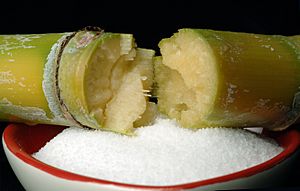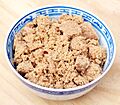List of sugars facts for kids
This is a list of different kinds of sugars and sugar products. Sugar is a general name for sweet things that are often used in food. They are a type of carbohydrate made of carbon, hydrogen, and oxygen. Sugars come from many different plants and sources.
When you see chemical names ending in "-ose," it usually means they are sugars. For example, glucose or fructose. A "syrup" is a thick, sweet liquid made from sugar dissolved in water.
Some sugars are made by processing grains like wheat or barley. This is called "malting." So, "malt extract" is mostly sugar. Most sugar comes from plants. People squeeze out the plant juice, then dry it to get sugar crystals. This is why things like "evaporated cane juice crystals" are very similar to pure sugars.
Different Kinds of Sugars and Sweet Products
Here are some common types of sugars and sweet products you might find:
- Agave syrup – This syrup comes from the agave plant. It has a lot of fructose and is sweeter than honey.
- Arabinose – A type of sugar that is not very common in foods.
- Barbados sugar – A soft, moist, and fine-grained brown sugar.
- Barley malt syrup – This syrup is made from barley. It is about 65% maltose and 30% other carbohydrates.
- Barley sugar – A hard candy that is similar to caramel.
- Beet sugar – This sugar is made from sugar beets. It has a lot of sucrose.
- Birch syrup – Made from the sap of birch trees. It contains fructose, glucose, and a little sucrose.
- Brown sugar – This sugar gets its color and flavor from molasses. Light brown sugar has less molasses than dark brown sugar.
- Buttered syrup – A syrup with butter added for flavor.
- Cane sugar (also called cane juice or cane juice crystals) – This sugar comes from sugarcane plants and is mostly sucrose.
- Caramel – A sweet, chewy substance made by heating various sugars until they turn brown.
- Carob syrup – A sweet syrup made from the pods of the carob tree.
- Caster sugar – A very fine type of granulated sugar.
- Coconut sugar – Made from the sap of coconut palm trees. It contains mostly sucrose, plus some glucose and fructose.
- Confectioner's sugar (also known as "icing sugar" or "powdered sugar") – Very finely ground sugar, often with a little cornstarch to prevent clumping.
- Corn sugar – This is another name for dextrose, which is made from corn starch.
- Corn syrup – A sweet syrup made from corn starch. It can contain glucose, maltose, and other sugars.
- Date sugar – Made from dried dates that are ground into a powder.
- Dehydrated cane juice – Sugarcane juice that has had its water removed.
- Demerara sugar – A light brown, coarse-grained sugar often used in baking or to sweeten drinks.
- Dextrin – A type of carbohydrate made from starches. It doesn't taste very sweet.
- Dextrose – This is the same as glucose. It's a simple sugar.
- Disaccharide – Also called a "double sugar." It's made when two monosaccharides (simple sugars) join together. Examples include sucrose, lactose, and maltose.
- Evaporated cane juice – Similar to dehydrated cane juice, it's the juice from sugarcane with the water removed.
- Free sugar – This term refers to all sugars added to food, plus sugars naturally found in honey, syrups, and fruit juices. Sugars inside whole fruits are not included.
- Fructose – A simple sugar found in many plants, especially fruits. It often combines with glucose to form sucrose.
- Fruit juice and Fruit juice concentrate – Liquids pressed from fruits, containing natural sugars. Concentrates have most of the water removed.
- Fucose – Another type of sugar, not commonly found in foods.
- Galactose – A simple sugar that is not as sweet as glucose or fructose.
- Glucose and glucose solids – A very important simple sugar that our bodies use for energy. Glucose solids are dried glucose.
- Golden syrup and golden sugar – These are refined syrups or sugars made from sugar cane or sugar beet juice.
- Grape sugar and grape juice – Sugars or juice from grapes.
- High fructose corn syrup (HFCS) – A sweetener made from corn starch. It has a high amount of fructose.
- High maltose corn syrup – A corn syrup that mainly contains maltose. It is not as sweet as high fructose corn syrup.
- Honey – A sweet food made by bees. It is mostly made of fructose and glucose.
- Inositol – A type of sugar alcohol found naturally.
- Inverted sugar syrup – A sweet, clear liquid made by breaking down sucrose. It is used to keep foods moist and prevent sugar from crystallizing.
- Jaggery – A traditional unrefined sugar made from date palm, sugarcane, or palm sap. It contains sucrose and other sugars.
- Lactose – Sometimes called milk sugar. It is found in milk and dairy products.
- Malt extract or malt syrup – A sweet, sticky, brown liquid made from barley.
- Maltose – A double sugar made from two units of glucose joined together.
- Maltodextrin – A white powder or liquid made from starches like corn, potato, or rice. It is a sugar polymer but does not taste sweet.
- Mannose – Another type of sugar.
- Maple sugar – Sugar made from the sap of maple trees. It is mostly sucrose.
- Maple syrup – A sweet syrup made from the sap of maple trees. It is also mostly sucrose.
- Molasses (from sugar beets) – A thick, dark syrup left over after sugar is made from sugar beets. It contains sugars like sucrose, glucose, and fructose.
- Molasses (from sugar cane) – A thick, dark syrup left over after sugar is made from sugarcane.
- Monosaccharide – These are "simple sugars," the most basic building blocks of carbohydrates. Examples are glucose, fructose, and galactose.
- Muscovado – A dark, unrefined brown sugar with a strong molasses flavor.
- Non-centrifugal cane sugar – Sugar made by simply evaporating sugarcane juice without spinning it in a machine.
- Palm sugar – Made from the sap of various palm trees.
- Panela – An unrefined whole cane sugar, common in Latin America.
- Penuche – A type of fudge made with brown sugar.
- Powdered sugar – See Confectioner's sugar.
- Raw sugar – Sugar that has been minimally processed.
- Refiner's sugar and refiner's syrup – Products from the sugar refining process.
- Ribose – A sugar that is part of RNA and DNA in our bodies.
- Rice syrup – A sweetener made from rice.
- Rhamnose – Another type of sugar.
- Saccharose – Another name for sucrose.
- Sorghum syrup – A sweet syrup made from sorghum plants.
- Sucrose – Often called white sugar, granulated sugar, or table sugar. It is a double sugar made of glucose and fructose. It comes from sugarcane juice or sugar beet juice.
- Sugarcane – A tall grass plant that contains a lot of sucrose.
- Sweet sorghum – A type of sorghum grown for its sweet stalks.
- Syrup – A thick, sweet liquid.
- Table syrup – A general term for syrups used at the table, like pancake syrup.
- Treacle – Any uncrystallized syrup made during the process of refining sugar.
- Trehalose – A natural double sugar made of two glucose units.
- White sugar – Refined sucrose, often called table sugar.
- Yellow sugar – A type of brown sugar that is lighter in color.
- Xylose – A sugar found in plant cell walls.
Images for kids
See also





